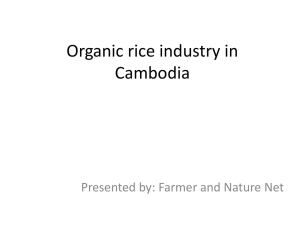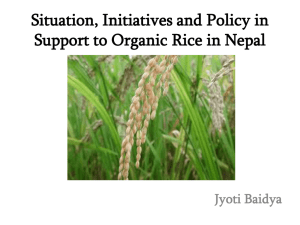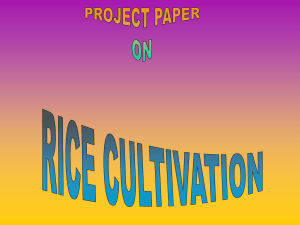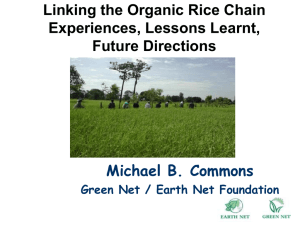ENVIRONMENT AND ECONOMIC ASPECTS OF RICE
advertisement
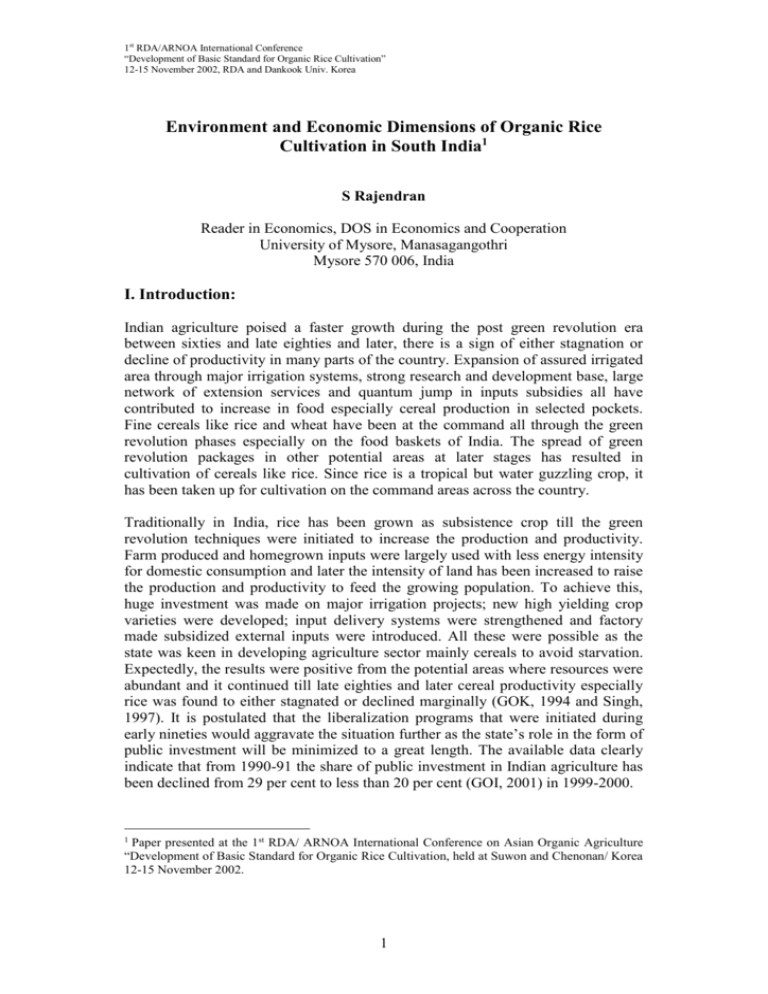
1st RDA/ARNOA International Conference “Development of Basic Standard for Organic Rice Cultivation” 12-15 November 2002, RDA and Dankook Univ. Korea Environment and Economic Dimensions of Organic Rice Cultivation in South India1 S Rajendran Reader in Economics, DOS in Economics and Cooperation University of Mysore, Manasagangothri Mysore 570 006, India I. Introduction: Indian agriculture poised a faster growth during the post green revolution era between sixties and late eighties and later, there is a sign of either stagnation or decline of productivity in many parts of the country. Expansion of assured irrigated area through major irrigation systems, strong research and development base, large network of extension services and quantum jump in inputs subsidies all have contributed to increase in food especially cereal production in selected pockets. Fine cereals like rice and wheat have been at the command all through the green revolution phases especially on the food baskets of India. The spread of green revolution packages in other potential areas at later stages has resulted in cultivation of cereals like rice. Since rice is a tropical but water guzzling crop, it has been taken up for cultivation on the command areas across the country. Traditionally in India, rice has been grown as subsistence crop till the green revolution techniques were initiated to increase the production and productivity. Farm produced and homegrown inputs were largely used with less energy intensity for domestic consumption and later the intensity of land has been increased to raise the production and productivity to feed the growing population. To achieve this, huge investment was made on major irrigation projects; new high yielding crop varieties were developed; input delivery systems were strengthened and factory made subsidized external inputs were introduced. All these were possible as the state was keen in developing agriculture sector mainly cereals to avoid starvation. Expectedly, the results were positive from the potential areas where resources were abundant and it continued till late eighties and later cereal productivity especially rice was found to either stagnated or declined marginally (GOK, 1994 and Singh, 1997). It is postulated that the liberalization programs that were initiated during early nineties would aggravate the situation further as the state’s role in the form of public investment will be minimized to a great length. The available data clearly indicate that from 1990-91 the share of public investment in Indian agriculture has been declined from 29 per cent to less than 20 per cent (GOI, 2001) in 1999-2000. 1 Paper presented at the 1st RDA/ ARNOA International Conference on Asian Organic Agriculture “Development of Basic Standard for Organic Rice Cultivation, held at Suwon and Chenonan/ Korea 12-15 November 2002. 1 1st RDA/ARNOA International Conference “Development of Basic Standard for Organic Rice Cultivation” 12-15 November 2002, RDA and Dankook Univ. Korea In this scenario, it is perceived that the cost of cultivation is shooting up and the farmers are finding that agriculture is no more viable proposition and in fact a large number of farmers committed suicides in a south Indian state of Karnataka (Deshpande, 2002). Perhaps shooting up of price of factory made external inputs and the government slow withdrawal of investment as well as market intervention and more significantly, shifting of subsistence farming (mainly with homegrown inputs) to commercial farming (largely with purchased inputs) would have also contributed for the present crisis. In other words, the local indigenous farm techniques have been wiped out and replaced by the modern techniques that would have resulted unviable and unsustainable farm enterprise. Rice as a major cereal crop, grown across the country is also facing the same problem and challenge like any other crop and over 90 per cent is produced and consumed in the Asian continent. Countries like China, India, Philippines, Korea and Pakistan grow a lion’s share of global rice production. Though the rice yield levels differ across these countries, suitable agro-environmental conditions favor the farmers to grow this crop. Rice is predominantly grown in the states of Punjab, Haryana, West Bengal, Tamil Nadu and Andhra Pradesh in India. Nevertheless, rice cultivation becomes less remunerative, environmentally unsustainable, and hence alternative crops have been propagated and this option will be less subscribed as a large chunk of Asian population’s staple food is rice. It is in this context that alternative farm techniques and strategies for growing rice ought to be found in the larger interest. Owing to the merits of organic cultivation as compared to modern practice, such principle is attracted across the world. Much state supported agencies; NGOs and individuals started experiments on organic methods of production in the recent past. Many European countries provide financial assistance to farmers for organic cultivation in the context of health and environmental implications of conventional farming systems. The recently held 14th Organic World Congress in Canada emphasized the need for promoting ecologically sustainable, economically viable and socially adaptable farming system. In fact there is a growing demand worldwide, especially in the European region for organically grown food products as could be observed from the table – 1. 2 1st RDA/ARNOA International Conference “Development of Basic Standard for Organic Rice Cultivation” 12-15 November 2002, RDA and Dankook Univ. Korea Table: 1 – Organic Food Market – A Glance in 2000 Markets Retail sales Total food sales Expected growth (in billion US$) (in per cent) (in per cent) Germany 2.2-2.4 1.25-1.5 10-15 United Kingdom 1.0-1.05 1.0 25-30 Italy 1.0-1.05 1.0 15-20 France 0.75-0.80 1.0 15-20 Switzerland 0.42-0.45 2.0-2.5 15-20 Denmark 0.35-0.37 2.5-3.0 10-15 Austria 0.25-0.30 2.0 10-15 Netherlands 0.22-0.27 0.75-0.10 10-20 Sweden 0.12-0.15 1.0 20-25 Other European countries 0.30-0.40 NA NA Europe total 7.0 United States 8.0 1.5 15-20 Japan 2.50 NA NA Total 17.50 Note: Official trade data are not available. Compilations are based on rough estimates. The figures for Japan include ‘green products’. Source: DTE, 2001, p35. The increase in demand for organic products is mainly due to health implications and scare triggered by bovine encephalopathy (BSE) in livestock, dioxin in animal feed and genetically modified products. Thus scared public in the Europe and America ready to pay premium for organically grown products mainly come from developing countries and even within the developing countries, urban rich consumers prefer to consume organically grown products. This clearly reveals the fact that market is growing at faster pace for organic commodities in the globe and higher premium is mainly due to cost escalation in the organic farming systems (Hazell, 2001). II. Challenges: According to researchers, different farming systems do have implications on the productivity, sustainability, production orientation and ecological situations (see Werf and Narayan, 1989 and Pingali, Hossain and Gerpacio, 1997). While modern commercial (conventional) farming system is unsustainable and market oriented the organic (sustainable) farming do have merits like productivity orientation, ecological sustainability and farm complexity (Table – 2). 3 1st RDA/ARNOA International Conference “Development of Basic Standard for Organic Rice Cultivation” 12-15 November 2002, RDA and Dankook Univ. Korea Table: 2 – Postulates of Different Farming Systems System variables Conventional farming Organic farming Productivity High High Sustainability Low High Farm complexity Simple Complex Environment diversity Uniform Diverse Production orientation Market Subsistence and External inputs or Market i)Seeds HYVs Improved local ii)Agro-chemicals High None Source: Werf and Narayan, 1989. Traditional farming Low Moderate Complex Diverse Subsistence Local Low Traditional rice cultivation involves mainly direct sowing, interculture, weeding, rainfed irrigation and harvest. In such system, rice plants withstood extreme drought, provided more fodder and yield was moderate for subsistence. Research study in the Philippines indicated that in rainfed low land farms dry seeding of rice in dry plowed plots was the promising technology for improving rice productivity (IRRI, 1992). Subsequently, the introduction of semi and dwarf varieties of high yielding varieties of rice, resulted in prone and succeptable to pests and diseases, required more water, demanded more factory made external inputs (especially agro-chemicals) and yielded less fodder. The propensity to use abundant water and more chemicals increased year after year. In some pockets of rice regions in India, indiscriminate and non-judicial use of chemicals was observed that has also led to health hazards on the labor (Mencher, 1994). Nonetheless, such varieties yielded more which was essential to feed the growing population. Simultaneously, adverse ecological impacts like water logging, salinity and chemical contamination were reported (Pingali, 2001 and Rajendran, 2002). In addition to this, comprehensive studies on organic especially rice cultivation are scanty in India. Thus the relevance of organic agriculture and research has been realized all over the world. III. Data Source: With this backdrop the present paper intends to examine the environment and economic dimensions of rice cultivation from six farms in four south Indian states – Karnataka (2), Kerala (1), Pondicherry (1) and Tamil Nadu (2). The selected organic farms were visited to get the details on environment and economics aspects of rice cultivation. Basically, rice is grown on the farms for domestic consumption and some farmers gave a portion of rice products to their friends and relatives and however, other crops like fruits and vegetables were grown for both domestic and marketing. The resource endowments were highly diversified and found more among organic growers. Such farmers maintained a good number of livestock (for dung, milk and draught power), agro-forestry (for green manure) and adapted mixed crops including horticulture for sustainable income. These enabled the organic growers to avail and use the home grown resources as inputs in growing crops including rice and it was cost effective. 4 1st RDA/ARNOA International Conference “Development of Basic Standard for Organic Rice Cultivation” 12-15 November 2002, RDA and Dankook Univ. Korea The rice growers collected 2 seeds from their fields, dried, processed and stored them in eco-friendly containers like bamboo bins, wooden grainage and paddy straw bin. Inside the containers, some farmers kept leaves from tulsi, lotus, neem and notchi plants, others put dry chilies to check pests like whit moth, which was found as common infested on the seed. While a couple of farmers preferred to sow the seeds, some went in for raising nurseries and thus seedlings grown on the seed beds were collected carefully for transplantation. It was observed that local crop varieties were preferred for cultivation, though such varieties extinct from such localities and the organic growers stored some seeds as treasure of troves. For raising seedlings, green leaves like pongamia and neem (sometimes paddy husk) were applied as compost, which enabled the soil to be porus and this prevented wastage of seedlings and increased shooting capacity of clumps. Row method of transplanting paddy was practiced, which helped the farmers to remove the weeds, control rats and sufficient aeration was found and all these resulted in increasing the yield levels significantly. IV. Ecological Implications: Application of bad odor, cattle urine mixed with neem and adathudai (botanical) decoction kept at bays the pests and diseases in the rice fields. A couple of organic rice growers confessed that application of neem oil cake along with organic manure as basal fertility agent prevented insect pests and diseases3 attack; enhanced plant growth and increased yields. Due to non-availability of sufficient organic manure, a few farmers purchased municipal waste and applied the same after due processing4. While for transplanted fields, water was applied on alternate days, directly sown (broadcaste) fields; this was done weekly twice. It is to be remembered that while water scarcity is noted everywhere across the globe, to produce one kilo of rice the farmers in general reported to use an alarming quantum of about 15000 liters (Rajendran, 1992) under flood irrigation system for rice transplanted fields. Such huge water use resulted not only in excessive weed growth but also salination and water logging erupted in the long run. In fact, interculture 5 was done with an intention to split root system (for more shoots and clumps) of the rice plants and to reduce the weed growth and instead only the former was realized, weed growth was found to be more. This had resulted in using more human labor for weeding operation and the wage for transplantation offset this cost as revealed by the 2 Unlike in modern rice varieties, grains can be easily threshed from the traditional crop plants. Mechanical thresher or beating the plants on hard stone under modern HYV, germination quality is affected to a great extent. 3 Common pests in rice are blue leaf beetle (Leptispa pygmaea Baly) and Rice grasshopper (Hieroglyphus banian) and diseases are blast (Piricularia oryzae) and Leaf Yellowing (Tungro). 4 In fact there was growing demand for municipal compost in the predominantly rice grown regions and farmers spent substantial amount as wage for separate out solid wastes like plastics, glass pieces and iron materials. 5 Well after 20 days of sowing paddy seeds, interculture with either bamboo splits or wooden plow was done for increasing plant shootings. Farmers reported that such plots shown greater intensity of drought resistant and yield was comparable with transplanted fields. 5 1st RDA/ARNOA International Conference “Development of Basic Standard for Organic Rice Cultivation” 12-15 November 2002, RDA and Dankook Univ. Korea organic rice growers. Moreover, under direct sowing, other crops like ragi and jowar were grown as mixed/inter crops on the uplands that maintained providing supplementary income. Besides, black gram, white gram, pigeon pea and cow pea were raised on the field bunds both on rice seedlings transplanted and direct sown fields and often, this kept the pest and disease well under control and also served as habitation for natural predators like spiders. Other inputs like application of earthworm castings and algae especially on the irrigated plots were also noted among the selected organic rice growers. Earthworms proliferate by themselves in the absence of chemicals in the soil whereas algae grew naturally, if the environment is congenial. Unfortunately, it was revealed that realizing the fast growing market (demand) for earthworm castings, the fake businessmen entered the field and exploited the farmers. Also in some places in the state of Maharasthra and Karnataka, it was reported that fertile black soil was adultrated with earthworm castings for quick and easy money and farmers were duped. This warrants immediate attention of the policy makers to streame line the market mechanism like licencing and standardization. Scientific studies from the University of Agricultural Sciences in Bangalore, clearly demonstrated that earthworm castings contain five times more nitrogen, seven times more phosphate and 11 times more of potash than the given top soil. Fragoso and Lavelle (1995) found that litter decomposition by earthworms’ help improved the soil nutrients and organic matter. Rigorous scientific screening and standardization is lacking in this crucial aspect. For instance, in India there are more than 200 varieties of worms and so far only three varieties like Eudrilus eugeniae and Perionyx excavatus for tropical conditions and Eisenia fiteda for temperate conditions have been found suitable than others. Unless proper screening and labeling is done, it would resort to black marketing. With regard to earthworms, fields should not be plowed more deeply and intensively instead light plowing or rotating top soil with spade created a favorable atmosphere to faster proliferation. Absence of chemical particles (synthetic fertilizers and pesticides) helped the worms to multiply themselves in the soil thereby the excreta of worms enriches soil fertility, plant growth, grain weight and yields levels. Similarly, there is a growing demand for bio fertilizers like algae especially among the rice growers. Commonly used bio fertilizers to fix/solubilize atmospheric and naturally occurring plant nutrients are blue green algae (bga), Azolla, Rhizobium, Azospirillum and Azotobater. Such algae are found not only cheaper but also easy to grow by the farmers in their fields with little technical expertise. There is a growing awareness on this not only among organic rice producers and from other farmers as well in states like Tamil Nadu and Karnataka, where the ecological and economical merits of bio fertilizers have been highlighted on the vantage points by the state machineries. Despite these, it was found that only 10 per cent of total demand of bio fertilizers was met by the state departments and there is a potential for private sector to exploit the business on a large scale as it is economical, technically feasible and ecologically sustainable. Perhaps the financial institutions may come forward to start this as agri-business in rural areas and already a couple 6 1st RDA/ARNOA International Conference “Development of Basic Standard for Organic Rice Cultivation” 12-15 November 2002, RDA and Dankook Univ. Korea of large fertilizer companies ventured in this prosperous area for production and marketing. Standardization of production and marketing of bio fertilizers need to be done at micro level with the active help of agricultural scientists and revenue officials. As per the available information five promising microorganisms like Nostoc sp, Aulosira sp, Anabaena sp, Oscillatoria sp and Westiellopsis sp, were identified as efficient nitrogen fixing agents under All India Coordinated research project on bio fertilizers. This has to be viewed in the interest of long term ecological benefits as continuos application of algae for three years farmers need not use synthetic fertilizers because micro organisms will get well established in the soil and be able to generate nutrients, required by rice crop. Despite these, scientific research studies conducted at Tamil Nadu’s Rice Research Institute at Aduthrai, revealed that rice productivity was 20 per cent higher when treated with bga, Azospirillum and chemical fertilizers than when treated with bga and Azospirillum only or synthetic fertilizers alone6. Organic rice growers on the other argued that continuos application of eco-friendly bio fertilizers enabled the farmers to get more yields. The organic rice growers grew leguminous crops like kozunji and sanabhu during off farm summer season on the fields. Similarly, some farmers penned sheep flock at nights for manure and they reported that sheep urine and manure enriched the soil fertility. This had helped to increase the soil fertility and in turn yield levels. Another notable observation is that fodder availability from dwarf and semi dwarf rice varieties was less as compared with traditional ones. But as of now even the organic rice growers do not possess traditional seed varieties of any crop and high yielding crops completely occupied the prime position especially on the assured irrigated regions. Local crop varieties were used only in remote dry land regions. In the selected organic farms, rice varieties developed from the International Rice Research Institute in the Philippines have been crossed with local varieties by the state run agricultural universities and the Indian Council of Agriculture Research stations and only such varieties were grown on the irrigated fields. Thus low availability of fodder from modern high yielding varieties, resorted in fodder shortage for livestock sector and hence purchased feed items were fed to domestic animals. V. Economic Aspects: As it was observed, organic rice growers relied, more on homegrown items like crop residues, compost and green manure, which brought down cash component of expenditure for inputs. Only a major item that incurred more input cost was farm power sources like human labor, draught animals and machineries. Obviously, rice requires more farm power for operations like plowing, leveling, transplanting, 6 During a personal interview with agriculture scientist, M S Swaminathan in December 1993, he ascertained as “Bio fertilizers are not alternative to chemical fertilizers. But they can enhance the availability of plant nutrients from the soil”. P22 (Rajendran, 1993). 7 1st RDA/ARNOA International Conference “Development of Basic Standard for Organic Rice Cultivation” 12-15 November 2002, RDA and Dankook Univ. Korea irrigation, weeding, harvesting and threshing. Of course, between successive operations, rice growers get adequate leisure. A cross section of the organic rice growers reported that rice is fairly remunerative crop as compared with other cereals like ragi, jowar and bajra. On an average rice yields were reported around five tones for one hectare of land for transplanted system and little less than under direct sowing system. Since manual weeding was done and home-grown inputs were applied the input costs were considerably reduced. Perhaps, yield levels under conventional type of farming would have been more but the yield per rupee invested could have been more under organic farming. On an average Rs 20000 was generated as net income from growing rice from one hectare of land and farmers reaped twice as income over investment as could be found from Table –3. Nevertheless, economics of production for different crops shows that horticulture crops were more remunerative as compared with cereals including rice under organic agriculture. Table: 3 – Costs and Returns of Selected Organically Grown Crops (RS/ha) Crops Gross Cost Gross Returns Net Returns Net Returns over Cost (per rupee) Coconut 14000 140000 126000 9.0 Sapota 16000 87000 72000 4.5 Turmeric 7800 30000 22200 2.9 Grapes 40000 150000 110000 2.8 Groundnut 6000 22000 16000 2.7 Tomato 80000 250000 170000 2.1 Rice 10000 30000 20000 2.0 Tea 90000 NA NA NA Curry leaves NA 15000 15000 NA Note: For groundnut and rice costs and returns were worked out for one crop season and for other crops for one year. Source: Rajendran (1998). This table clearly depicts the fact that rice is less productive crop as compared with other horticultural crops among the selected farms. This could be mainly due to accounting of different costs and nature of crop. For instance, perennial crops like coconut and sapota were well established there may not involve much cost unlike rice. Additionally the market price for cereals is not commensurate with the increase in input cost. But still the organic farmers preferred to grow rice as one of the crops on their plots mainly for domestic consumption. Notably, another study (ICSIM, 1990) reported that mean yield levels from organic farms in the states of Karnataka and Tamil Nadu were comparable that of conventional farms. Here crops like rice, minor millets (ragi and jowar) registered more yields, groundnut and sesame recorded low yields from organic farms than modern (conventional) farms. 8 1st RDA/ARNOA International Conference “Development of Basic Standard for Organic Rice Cultivation” 12-15 November 2002, RDA and Dankook Univ. Korea Employment generation was found more under organic rice cultivation as weeding was exclusively done with manual labor. Human labor also did some operations like catching rats during pollination and grain formation stages and a substantial amount of human labor was used for weeding operation in the direct sown rice plots as compared with transplanted fields. Moreover, each and every operation and supervision was done with utmost care and organic growers were concerned with ideology than mere economic returns. VI. Conclusions and Suggestions: The above discussion explains that organic rice cultivation is associated more towards farm oriented self sustained system. Strong local resource endowment, sustained commitment and ideology have influenced the organic farmers to go in for raising rice under organic system in combination with traditional expertise. Arguably, adoption of specific farm practice based on rich local experience helped the growers to sustain the rice production. Followed by this, the local farm based resources like livestock and farm forestry are also found to influence the rice cultivation. Though rice cultivation appears to be less economical as compared with other crops, there is a scope for minimizing the economic cost and environmental loss, under organic farming system as compared to conventional farming in the long run. Besides these, environmental balance is maintained where, crops, trees, animal and man can live more harmoneously. Major issues like standardization of necessary inputs like vermicompost and biofertilizers need to be addressed by keeping environment and economic dimensions of agricultural sustainability in the long run. Similarly, marketing for certified as organically grown products is a tiresome process and costly that affects the Indian growers who are interested to export the commodities (DTE, 2001). This needs to be simplified while keeping the quality of products and human health in view. References: Deshpande R S (2002) Suicides by Farmers in Karnataka – Agrarian Distress and Possible Alleviatory Steps, Economic and Political Weekly, XXXVII(26):2601-2610. Down To Earth (2001) Organic Farming - Untapped Potential, 10(8): 34-41. Fragoso Carlos and Patrick Lavelle (1995) Are Earthworms Important in the Decomposition of Tropical Litter? In Soil Organisms and Litter Decomposition in the Tropics Ed. M V Reddy, Oxford and IBH, New Delhi, pp103-112. GOK (1996) Report of the Expert Committee on Stagnation of Agricultural Productivity in Karnataka during 1980s, Bangalore. GOI, (2001) Economic Survey, Ministry of Finance, New Delhi. 9 1st RDA/ARNOA International Conference “Development of Basic Standard for Organic Rice Cultivation” 12-15 November 2002, RDA and Dankook Univ. Korea Hazell Peter (2001) Agriculture and the Environment, Environment and Development Economics, 6 (Part 4) October, pp516-521. International Rice Research Institute (1992) Program Report for 1991, Los Banos, Laguna, Philippines. ICSIM (Institute for Command Area Studies and Irrigation Management) (1990) Organic Farming in Karnataka and Tamil Nadu, Project report, Bangalore, Unpublished. Mencher J P (1994) Agricultural Labor and Pesticides in Rice Regions of India: Some Health Considerations, Economic and Political Weekly, XXVI(39):2263-68. Pingali P L (2001) Environmental Consequences of Agricultural Commercialization in Asia, Environment and Development Economics, 6 (Part 4) October, pp 483-502). Pingali P L, M. Hossain and R V. Gerpacio (1997), Asian Rice Bowls: The Returning Crisis? Wallingford: CAB International. Rajendran S (2002) Pesticide Spraying in Kerala – Human Cost and Environment Loss, Economic and Political Weekly, XXXVII(23):2206-2207. -------------- (1998) An Exploratory Study on Organic Farming System in India, In Living Resources for the Millennium, J William, Ed, Loyola College, Chennai. -------------- (1993), Of Algae, Worms and Cash Flow, Down To Earth 2(15):22-24. -------------- (1992) Water Use is excessive in Rice Cultivation, Down To Earth, 1(14):41. Singh R P (1997), Keynote address on People’s Technology and its Relevance in the Changing Scenario of Indian Agriculture at the Indian Social Science Congress, held at Tamil University, Thanjavur from 1-6 December. Werf E. van der and B Narayan (1989) A Socio-Economic Study of Ecological Agriculture in South India, AME and ICSIM, Project report, Bangalore, Unpublished. 10


